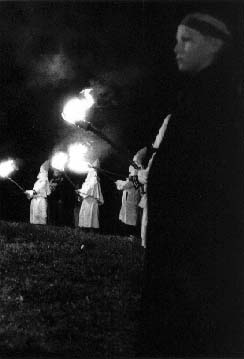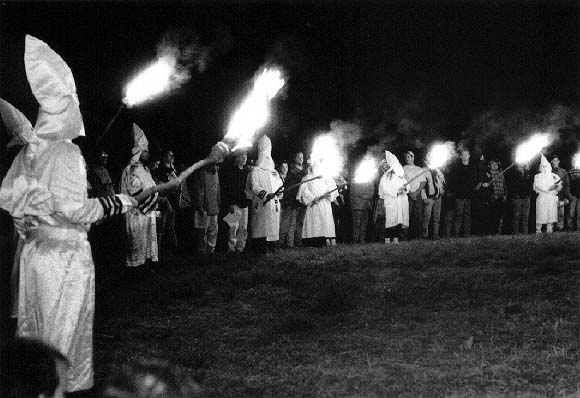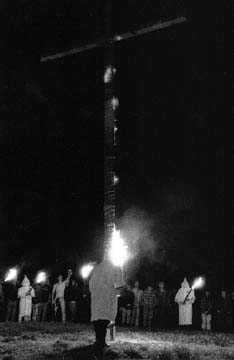A Gathering of the Klan:
a report of a Ku Klux Klan Rally held Saturday, October 14, 1995 in Fulton County, Illinois.
Published October 19, 1995 in the Zephyr, Galesburg, Illinois.
photos and story ©1995 by Norm Winick

Saturday, October 14th, brought an incredibly clear and comfortable evening to rural Fulton County Illinois. The wind had died down. Stars were visible from horizon to horizon. About an hour south of Galesburg, the county roads and the small towns seemed deserted.
But, just off Illinois Route 136, between the hamlets of Duncans Mills and Ipava, the flashing lights of several squad cars pierced the night. About half a dozen State Police officers and an equal number of Fulton County Sheriff's Deputies were standing alongside their vehicles at the entrance to an oil-and-chip county road. Where that road intersected the state highway, a hand-painted wooden sign leaned against a tree, reading only, "rally."
Before allowing anyone to pass, an officer shined his flashlight into every vehicle, asked about the driver's destination and if he was carrying any weapons. Satisfied, the cars were allowed to pass with an admonition not to park on the public right-of-way-- only on private property.
About half a mile further, another group of squad cars surrounded an entrance to a dirt path, bordered by trees and barely wide enough for a vehicle. Again, officers shined lights into the vehicles and asked a few perfunctory questions. Another crude sign labelled "rally" leaned against a bush where the two roads met.
Upon driving about a hundred feet, a young man in Desert-Storm camouflage said to park in the weeds to the right. He held out his flashlight to illuminate a path up a large steep hill where the faint outline of a tall cross could be seen.
The top of the hill was where the Klan was gathering.

This rally, called by the Chicago-based "Original Federation of Klans" was purportedly to protest the hiring of illegal aliens at a food processing plant in nearby Beardstown. A flyer distributed across Fulton County didn't mention that, however. It did give directions from Chicago and St. Louis, said that there would be no "drugs, firearms or alcohol" and indicated that food, drinks, shirts, literature and Klan souvenirs will be available.
The flyer stated, "The only reason that you are white today is because your ancestors believed in and practiced segregation yesterday."
Organizers had told residents that Fulton County was chosen because it was a mostly white county and there had never been a Klan rally there before. A newspaper editor in Lewistown said that, after running that story, he was bombarded with calls talking of cross lightings in the 1930s and 40s in the area.
The rally started at 4pm but, being the "invisible empire" that the Klan is, only members and guests were welcome at that time. In the starlight, a series of tents could be seen down the hill, where obviously the food and souvenirs were sold. On the top of the hill, surrounding the 30-foot tall wooden cross, were gathered about 200 individuals, mostly milling around.
They could have been waiting for a homecoming bonfire. The crowd was mostly young-- primarily from high school age to upper 30s-- wearing Nikes and Reeboks and Notre Dame and Michigan sweatshirts. A few sported some new souvenir T-shirts they had just purchased, but for the most part these were young men and women just like those who hang out in any mall anywhere.
Some folks brought their children. They stayed with their parents for the most part. There were a dozen or so couples who could have been out on a date and even more older couples, obviously married.
There were single teenagers and single older men. Some looked like farmers. Some looked like salesmen. There were a few skinheads; there were a few guys in pony tails.
But they all had one thing in common; they were white. They looked like any other crowd that might gather in Fulton County-- whether for a high school football game, a farm auction or to "cruise" the streets of Lewistown.
By 9pm, the crowd had formed a large circle surrounding the cross, and robed Klansmen started walking up the hill from the tent areas. As they joined the crowd, most in white hooded robes but some in black, they formed a circle inside the other. Forming that circle were 17 men and women, faces hidden, but clearly a somewhat diverse group also. Underneath the robes, there as at least one man in a suit and tie, one in a Nazi-like uniform, several in camouflage, girls in dresses, in jeans, and in army gear. The robes also varied. They had different numbers of stripes. Some were cotton; others were more satin-like.
They each picked up a torch from a pile near the large cross and Ed Novak, the Imperial Wizard, took center stage and addressed the crowd. Constantly turning so that he could face the gathering that surrounded him, Novak exhorted the virtues of the Klan, "the world's oldest whites' rights organization."
He talked of "White Power," while members of the audience shouted out racial epithets. They talked disparagingly of the O.J. Simpson verdict, of blacks in Fulton County, in Canton and in Galesburg. One of the more persistent contingents spouting off comments on keeping Pekin white.
Novak primarily talked in generalities: how the races were never meant to mingle and certainly never to intermix. He infused some Christianity into his talk-- claiming that the Aryan race is the chosen one and that all others are inferior.
After about 15 minutes, he asked his fellow Klansmen to come forward and to light their torches. They held them aloft as he used his to light the cross. As the flames traveled up the crucifix, the robed Klansmen stared through the eyeholes of their masks at the burning cross in the center of their circle.

Novak addressed the crowd: "I want my fellow Klansmen to face to their left. I want our guests to face to their right. Klansmen, walk in a circle clockwise. Guests, walk in a circle outside them in a counter-clockwise direction. If you are camera-shy or are only here to observe, step back behind the media." About half of the audience circled; half stayed behind.
As the flaming cross and torches illuminated the scene, two concentric circles were slowly moving-- robed Klansmen inside and a parade of others outside.
After each revolution or so, Novak would instruct everyone to stop. He would then tell a snippet of Klan history. He explained how the name "Ku Klux" comes from the Greek word kuklos meaning circle and that here we can see the inner circle of Klansmen and the others who support them. He said that "Klan" comes from the Scottish bands who united for a common cause.
At another halt, he would make some "White Power" statement or a call to arms to fight forces that are imposing integration of the races. There was never any mention of illegal immigrants in Beardstown.
After about half a dozen revolutions, Novak said that the ceremony was concluded. He thanked everyone for coming and invited the members and guests to pose for photographs. "Be sure to get some family photos," he added.
Some removed their hoods but most did not. For even in this non-threatening environment, it was clear that most Klansmen didn't want their identities known.
Ads the cars politely filed out, there was more diversity apparent. There were beat up pickup trucks, new Japanese sedans, mini-vans and a few Cadillacs. Cars had Illinois, Iowa and Wisconsin license plates and wheel tax or dealer stickers from Galesburg, Peoria, Pekin, Macomb, Canton, and a variety of Chicago suburbs.
Contacted several later, Novak said that there were many more Klansmen there than the ones in robes. "We had people from Iowa, Kentucky, Wisconsin and Alabama." He explained that the black-robed members were part of the Klan's security detail; "they're called 'Night Hawks.' The stripes are part of our rank identification or the position to which a member has been elevated."
Novak also said he is considering filing a harassment complaint against the State Police. "They were harassing our guests. They were asking questions they had no business asking. They were taking license plate numbers. One of our security details overheard a State Cop comment, 'those white robes sure would make a nice target.' They even told some folks that the rally was over and we hadn't even lit the cross yet. We're a fraternal organization. we have every right to meet and gather. When the Moose or the Elks get together on private property, the police don't harass them."
The Klan rally was indeed held on private property-- "leased" for the occasion according to Novak. County records indicate the owners are a couple named Larson from rural Virginia, Ill. who have no listed telephone number.
The only protester visible at the site was Terry L. Clark, a Methodist minister from Galesburg who stood at the entrance passing out a flyer proclaiming that the United Methodist Church finds it "particularly repugnant that a hate organization built on white supremacy and use of public or subtle violence cloaks itself as a 'patriotic Christian movement.'"
While the Klan was convening on the rural hillside, an anti-Klan rally was being held at Canton High School with about the same number of participants.
The Ku Klux Klan was first organized in Pulaski, Tenn. on Christmas Eve, 1865 as a way to defeat the Republican Reconstructionist governments-- both black and white. As the Reconstruction period ended, the Klan fell into oblivion only to be reborn in Georgia as a fraternal organization in 1915. It reached its peak, at a membership estimated at about three million in 1924. During this period the Klan held political control in several states, including Indiana. By 1929, after a period of violence and inept leadership, the Klan had again begun to diminish and was officially disbanded in 1944 for non-payment of taxes. After the civil rights movement of the 1960s, the Klan was again reborn.
Today there are a variety of separate organizations: the "Knights of the Ku Klux Klan;" the "United Klans of America;" the "National Klan" and the ones that were here, the "Original Federation of Klans."
One group, the Knights of the Ku Klux Klan, has even created a World Wide Web page on the internet. In a statement there, they try to shatter myths about their organization. They claim that the Klan doesn't hate black people-- that they just should be separate. They claim that they don't hate Catholics. They say that "Klan members take a pledge not to commit crimes.""The Klan is a gathering of white Christian men and women who are joined together because of the common bond they share by blood and faith."
In a platform statement, the political positions of the Klan are outlined. They include: "America first;" "Drug testing for welfare recipients;" "Protect America's birthright;" "Do away with affirmative action programs;" "Protect American jobs;" "Close our border" and "Outlaw homosexuality and interracial marriages."
The Kleagle, or newsletter, of the Ohio Ku Klux Klan, also on the internet, is much less benevolent. Linked to the "Christian Identity Online" homepage, it is primarily a tirade against blacks and Jews.
While most observers here and in Fulton County see the Klan as an aberration, their white supremacist views are not dying. The youth of the ralliers is a good indication of that. While the views may last, it would take a lot more that 250 people from several states to make a movement that needs to be feared. In some ways, the leadership seemed more concerned about keeping their "tradition" alive than actually doing anything.
That, however, may just be what they want you to believe.



